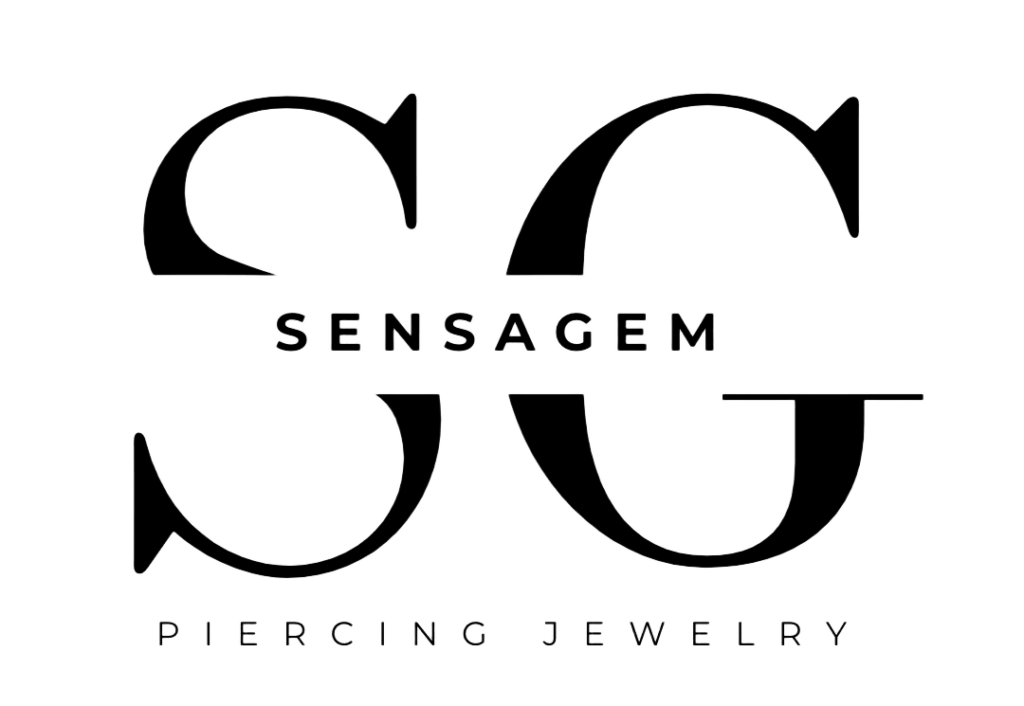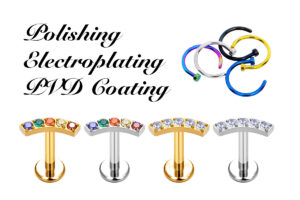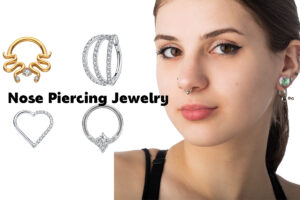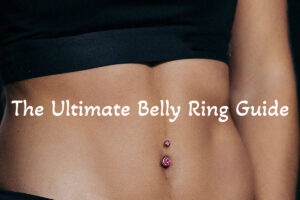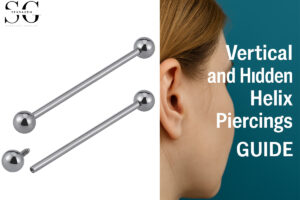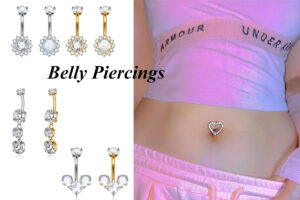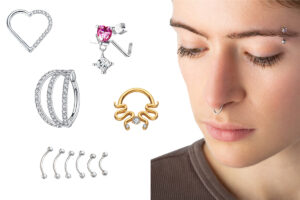導入: ジュエリーの種類を知ることが重要な理由
あなたが味付けされたピアサーかどうか, スタジオバイヤー, または、独自のオンラインストアを実行します, ピアスジュエリーを理解することは、きれいな部分を認識するだけではありません. 構造についてです, 安全性, 癒しの互換性、そしてもちろん、あなたの顧客が何を求めているのか.
それは感覚です, 私たちは輸入業者と話します, 卸売業者, 世界中のプロのピアサー. 一貫して聞くことの1つ: 製品をよりよく理解することができます, 選択しやすいです (そして売る) 正しいもの.
このガイドは、あなたが自信を持ってそれらの決定を下すのに役立つためにここにあります. 私たちはすべての主要なタイプのピアスジュエリーを歩きます - それらがどのように作られているか, 彼らが着用されている場所, どの材料が最も効果的であるか。だから棚を在庫することができます (そしてあなたのトレイ) 実際に顧客のニーズに合ったジュエリーで.
1. 構造によるジュエリー: それがどのように構築されるかは、それがどのように着用されるかに影響します
ジュエリーの内部工学は、訓練されていない目に見えないかもしれません, しかし、それは挿入がどれほど簡単かに直接影響します, それがどれほど快適に感じるか, そして、それがどれほどうまく癒されるか.
ここに、あなたが出くわす5つの最も一般的なピアスジュエリー構造があります。:
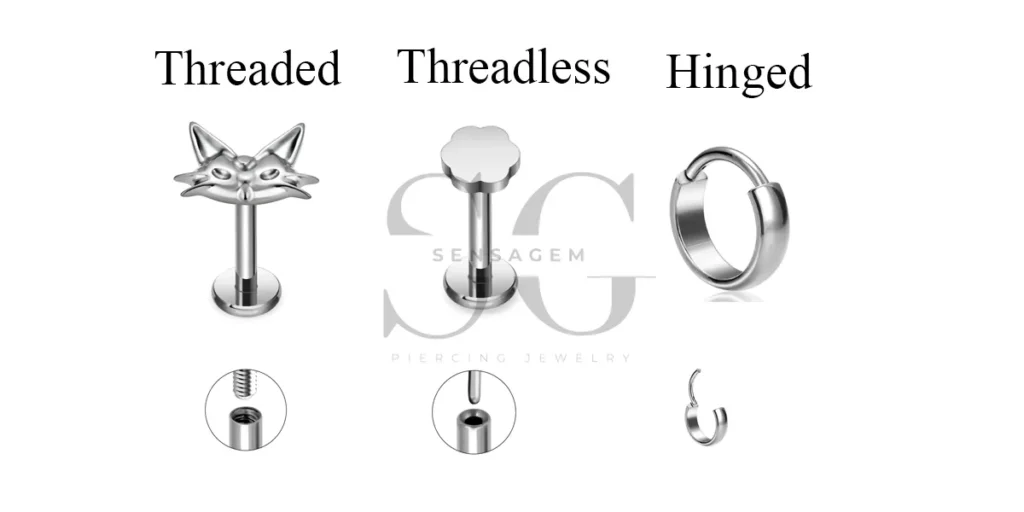
🔩外部スレッドジュエリー
これは、最も古く、最も伝統的なタイプです. あなたはそれを認識します スレッド (ネジ部分) 投稿に表示されます. 装飾的な端またはボールネジ に 外部スレッド付き投稿.
長所:
より手頃な価格
広く利用可能です
短所:
糸は、挿入時にピアストンネルを刺激する可能性があります
新鮮なピアスには理想的ではありません
に最適です:
コストが優先事項である癒しのピアス. 予算に優しい鼻孔スタッドを考えてください, ローブバーベル, 等.
🧲内部ねじで飾られたジュエリー
外部スレッドからのより安全なアップグレード. ここ, the スレッドは投稿内に隠されています, そして、装飾的な上部には、中に収まる小さなネジがあります.
長所:
スムーズな投稿: トラウマなしで挿入しやすい
スレッドエンドの強力なホールド
アプリが推奨 (プロのピアサーの関連)
短所:
生産の精度が向上したため、わずかに高いコスト
に最適です:
新鮮なピアス, ハイエンドスタジオ, 敏感肌の顧客. ほとんどのプロのグレードのラブレットとバーベルは内部ねじです.
👉関連の読み取り: さまざまな種類のピアスジュエリー構造を理解する
🧷スレッドレスジュエリー (プッシュフィットデザイン)
スレッドレスジュエリーは、現代のピアスで最も愛されている革新の1つです. 使用します 緊張フィットメカニック - 投稿にはネジがありません, そして、上部のピンは自分自身を所定の位置に保持するために少し曲がっています.
長所:
迅速かつツールのない挿入
超滑らかな表面=ゼロ刺激
ポストを維持しながらトップを簡単に交換できます
短所:
ピンを正しく曲げるわずかな学習曲線
ブランド間で常に互換性があるとは限りません
に最適です:
簡単で優雅さを希望するスタジオ. 癒しの唇に最適です, 鼻孔, トラガス, またはヘリックスピアス.
👉関連の読み取り: ラブレットピアスジュエリーに適したサイズを選択する方法
hingヒンジ付きセグメントリング & クリッカー
クリッカーとヒンジリングは、留め金のあるフープのように構成されています. ドアのヒンジのようにそれらを開き、閉じたスナップ.
長所:
シームレス, きれいな外観
失われた部分はありません - すべてが添付されています
快適で安全です
短所:
ヒンジは、繰り返し開口部で時間の経過とともに摩耗することができます
厚いゲージや複雑な配置では機能しない場合があります
に最適です:
セプタム, 旅, ヘリックス, そしてへそジュエリー. ファッションフォワードの顧客にとっては必需品です.
👉関連の読み取り: 円形のバーベルのノーズリング: 選択, 着ている, 維持
captiveキャプティブビーズリング (CBR) & シームレスなフープ
これらは古典的なフープスタイルです, 小さなビーズが張力または圧力を使用して所定の位置に「スナップ」する場所.
長所:
時代を超越した外観
ビーズは装飾的です (宝石, オパール, 等)
短所:
ツールなしで開閉する/閉じるのが難しいかもしれません
緊張は時間とともに緩む可能性があります
に最適です:
ローブ, 眉, 軟骨, そして親密なピアス. DIYに優しい顧客に適しています.
2. 形状のジュエリー & 関数: 適切なピースを右のピアスに一致させます
構造を理解した後, 次の最も重要な要素はです 形 - ジュエリーが体内または体内にどのように収まるか, それがどのように動くか, そしてそれがどのように見えるか. 特定の形状は、特定のピアス用に設計されています, 間違ったものを選択すると、刺激を引き起こす可能性があります, 移行, または長期の癒し.
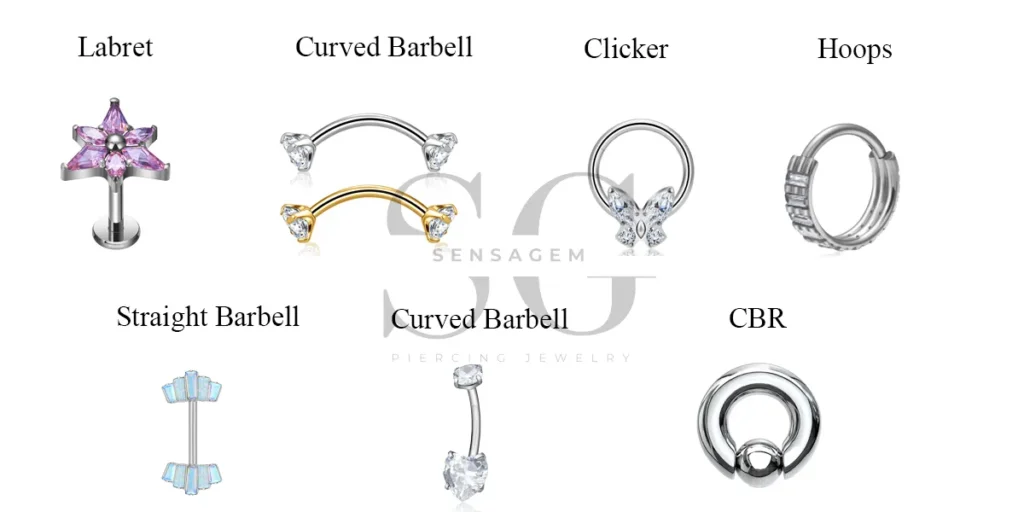
📎Labrets
構造: 一端にフラットディスク, 装飾的なトップ (スレッドまたはスレッドレス) もう一方.
一般的なゲージ: 16g, 18g
一般的な長さ: 6mm - 10mm
に最適です:
リップピアス (ラブレット, モンロー, メデューサ)
軟骨のピアス (トラガス, ヘリックス)
鼻孔ピアス (平らな背面が優先されるとき)
長所:
平らなディスクは口の中または耳の後ろに快適です
最小限の動き=より良い癒し
多くの場合、クイックスワッピングのためにスレッドレス
短所:
短すぎると腫れたピアスに沈むことができます
フラットディスクは、掃除されていないと皮膚の破片を閉じ込めることがあります
👉ヒント: チタンスレッドレスラブレット 最初のリップピアスのプロのスタジオの最大の選択肢です.
circular円バーベル
構造: 両端にねじ付きボールまたはスパイクを備えた馬蹄形の形状.
一般的なゲージ: 14g, 16g
一般的な直径: 8mm - 14mm
に最適です:
セプタムピアス
ダイスとルーク
眉と乳首のピアス
性器ピアス (アルバート王子, 等)
長所:
挿入して削除しやすい
装飾の終わりにより、カスタマイズが可能になります
厚いピアスとストレッチに適しています
短所:
ピアス内で回転できます
適切に締められないと、ねじ付き端が緩むことがあります
👉参照も参照してください: 円形のバーベルのノーズリング: 選択 & ヒントを着ています
curved湾曲したバーベル
構造: ねじれた端を備えた穏やかに湾曲したバー, 通常、ボール型.
一般的なゲージ: 16g, 14g
一般的な長さ: 6mm - 12mm
に最適です:
眉のピアス
へそ (へそ) ピアス
垂直ラブレット
ブリッジピアス
長所:
特定のボディ領域の自然な曲線に一致します
移動中の組織への圧力を低減します
複数の配置にはスタイリッシュで多用途が多い
短所:
高い動きの領域に常に適しているとは限りません
不適切なサイジングは移動を引き起こす可能性があります
📌 製品機能: SG6017 G23チタンねじ付き腹ボタンリング - 陽極酸化虹の仕上げを備えた古典的な湾曲したバーベル.
captiveキャプティブビーズリング (CBR)
構造: 真ん中に張力が保持されたビーズを備えたシームレスな円形のフープ.
一般的なゲージ: 16g, 18g
一般的な直径: 8mm - 12mm
に最適です:
鼻のピアス
耳軟骨 (ヘリックス, ルーク)
唇と眉
長所:
ビーズのアクセントを備えたクラシックな外観
挿入したら固定します
多くの色/素材があります
短所:
リングオープナープライヤーなしで挿入するのは難しい
緊張は時間とともに緩む可能性があります
🔗セグメントリング & クリッカー
構造: 位置にクリックするヒンジまたは取り外し可能なセグメントを備えたリング
一般的なゲージ: 16g, 14g
一般的な直径: 6mm - 12mm
に最適です:
セプタム, 旅
ローブとヘリックス
軟骨のピアス
乳首 (チャーム付きのクリッカー)
長所:
シームレスなデザイン
ツールなしで簡単に開閉できます
セキュアホールド, 敏感なエリアに最適です
短所:
ヒンジは時間の経過とともに摩耗する場合があります
複雑なメカニズムにより、より高価です
3. ピアスの場所によるジュエリー: 何を使用するか & 各体の領域を避けてください
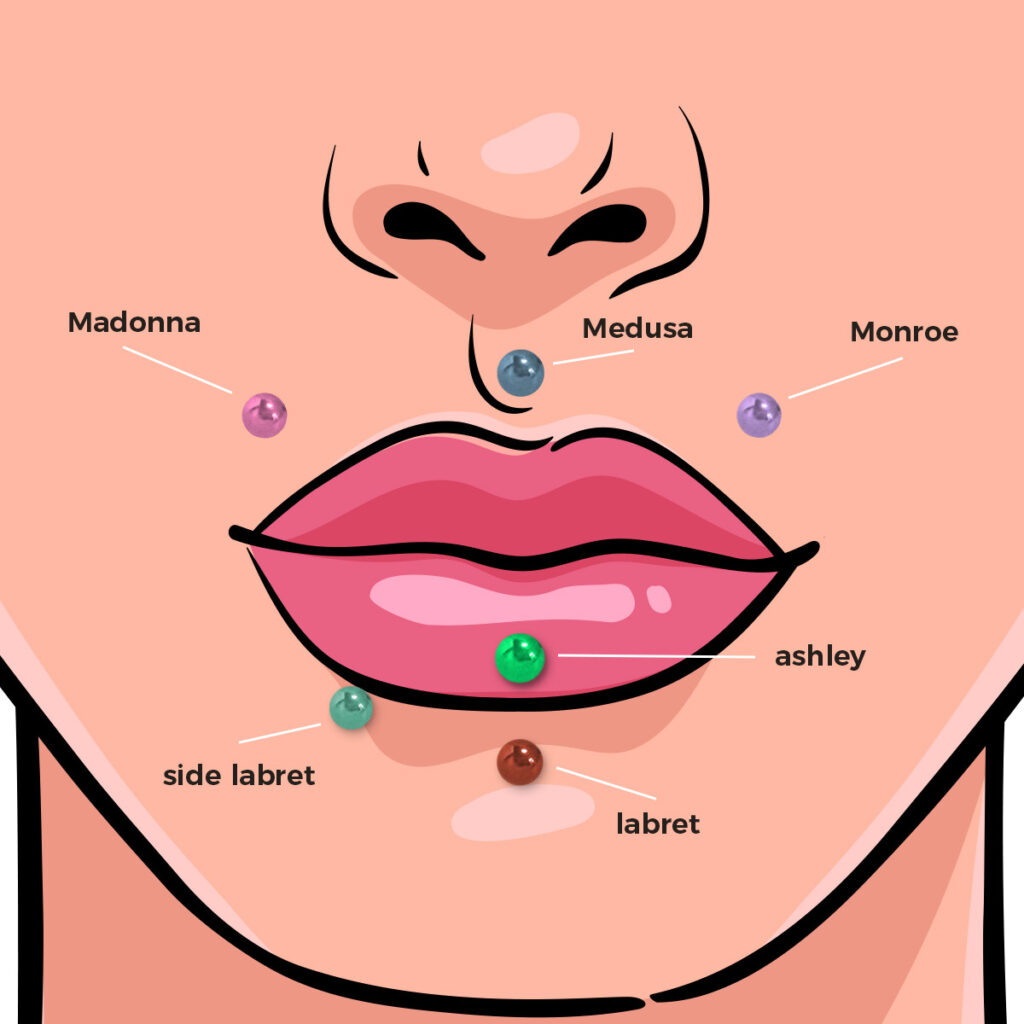
適切なジュエリーを選択することは、デザインだけではありません。 どこ 着用されます. 異なるピアス位置には、解剖学的要件が異なります. 間違った宝石を着ると、刺激を引き起こす可能性があります, 癒しが悪い, または、拒否の穴を開けることさえあります. それぞれの体の部分とそれらが重要な理由で最高のジュエリースタイルを分解しましょう.
🔗 関連する読書: さまざまな種類のピアスジュエリー構造を理解する
👂耳のピアス
人気のあるタイプ: 耳朶, ヘリックス, トラガス, 巻き貝, 産業, 旅
最高の宝石:
耳朶: ラブレット, スタッド, クリッカー, または小さなフープ
ヘリックス/トラガス: フラットバックラブレットまたはマイクロバーベル
産業: ストレートバーベル (通常14g, 解剖学に基づく正確な長さ)
ヒント:
新鮮なピアス用, インプラントグレードのチタンまたは316L手術鋼は最も安全です.
産業のピアスには正確な測定が必要です。バーベルが短すぎるか長すぎると移動を引き起こす可能性があります.
👃ノーズピアス
人気のあるタイプ: 鼻孔, 高い鼻孔, セプタム
最高の宝石:
鼻孔: L字型スタッド, ネジ, 小さなCBRS, およびスレッドレスプッシュフィットデザイン
セプタム: 円形のバーベル, シームレスなリング, またはヒンジ付きクリッカー
ヒント:
セプタムジュエリーは、鼻の中に快適に座るために適切に整列する必要があります.
チタンは、刺激のリスクが低いため、鼻のピアスに最適です.
👄リップ & 経口ピアス
人気のあるタイプ: ラブレット, モンロー, メデューサ, ヘビの咬傷
最高の宝石:
フラットディスクバックを備えたスレッドレスチタンラブレット
生体適合性のあるアクリルは、口の中で快適さを高めるために終わります
ヒント:
ジュエリーはエナメル質の損傷を避けるために口の中に洗い流す必要があります
Choose shorter bars post-healing to minimize movement and swelling
🧠 Bonus: Curious about how threadless jewelry works? Read スレッドレスデザイン: なぜそれが人気があるのか
💪 Body Piercings
人気のあるタイプ: へそ, 乳首, 表面
最高の宝石:
へそ: Curved barbells (typically 14G, 10mm) with externally or internally threaded balls
乳首: Straight barbell or circular barbell
Surface Piercings: Surface barbells or titanium anchors
ヒント:
Avoid CBRs in healing belly or nipple piercings; they tend to rotate and disrupt healing
For surface piercings, use flexible or internally threaded jewelry to prevent rejection
🌐 Want to learn more about barbells and curved designs? Check out カーブバーベル: サイズ, 用途 & 材料
🔒 Intimate Piercings
🔒 Intimate Piercings
人気のあるタイプ: Vertical Hood (VCH), アルバート王子, Christina, Frenum
最高の宝石:
Smooth, internally threaded titanium barbells or circular barbells
Jewelry must be custom-sized and polished to avoid irritation
ヒント:
Always use certified, hypoallergenic materials like ASTM F136 titanium
過酷な角度を避けてください, 粗いスレッド, または安価な金属合金 - 不快と衛生が重要です
4. 適切な素材を選択します: チタン, 鋼鉄 & 超えて
ピアスジュエリーに関しては, 素材はスタイルと同じくらい重要です. 見事なデザインは、それが刺激を引き起こす場合、または癒しの遅れを引き起こす場合、何も意味しません. あなたがスタジオの所有者であるかどうか, 卸売業者, または、安全な身体の変更に情熱を傾けています, 一般的な材料の長所と短所を理解することは、賢明に選択するのに役立ちます.

🧪チタン (ASTM F136 / G23)
なぜそれが人気があるのか: チタンは、最初のピアスのゴールドスタンダードと考えられています. 軽量です, 強い, 非腐食性, 完全にニッケルフリー.
主な利点:
hypoallergenic (敏感肌に最適です)
drantimprantip埋め物のために安全な認定 (ASTM F136標準)
brilent鮮やかな色に陽極化可能 (で詳細をご覧ください ピアスジュエリーのための陽極酸化 - チタン対. ステンレス鋼)
腐食耐性と軽量
に最適です: 最初のピアス, 敏感なクライアント, プレミアムジュエリーコレクション
surgicalステンレス鋼 (316l / 316LVM)
なぜそれがお気に入りなのか: 耐久性があり、手頃な価格, 手術鋼は、新鮮なピアスと癒されたピアスの両方に広く使用されています. しかし, トレースニッケルが含まれています.
主な利点:
✅強い, 手頃な価格, そして長持ちします
✅耐食性が優れています
bodyボディコンタクトに最適な鏡詰めされた表面
注意: 316 鋼は、ニッケル感度のクライアントに刺激を引き起こす可能性があります. これらの場合, 316l (低炭素) または316LVM (真空溶融) オプションが推奨されます.
に最適です: 癒されたピアス, 一括注文, そして毎日のウェア
違いを学びます: 316l対 316 外科用鋼 - ピアスジュエリーに最適なもの?
🧼バイオプラスチック, アクリル & PTFE
なぜそれがトレンドなのか: バイオプラストやPTFEのような非金属材料は、妊娠へのへそやMRIのように、柔軟性を必要とするピアスに最適です.
主な利点:
flexible柔軟で快適
vibrant鮮やかな色で利用できます
departion一時的な摩耗または癒しの移行期間に適しています
注意: 金属ほど耐久性はありません; 時間の経過とともに劣化する可能性があります. 評判の良いソースからのみ使用します.
に最適です: 妊娠セーフピアス, 医療処置, 軽量のフェイシャルジュエリー
材料 | 低刺激性 | 新鮮なピアスに適しています | 料金 | 耐食性 | カラーオプション |
|---|---|---|---|---|---|
チタン | ✅素晴らしい | ✅はい | 💲💲💲 | ✅素晴らしい | 🌈はい (陽極酸化) |
316l鋼 | moderate程度 | ⚠愛は注意してください | 💲💲 | ✅とても良い | ❌NO |
金 (14K+) | ✅いい | ✅はい | 💲💲💲💲 | ✅素晴らしい | 🌟はい |
バイオプラスト/PTFE | ✅はい | ✅はい (温度使用) | 💲 | moderate程度 | 🌈はい |
ニオブ | ✅素晴らしい | ✅はい | 💲💲💲 | ✅素晴らしい | 🌈はい |
5. スレッドタイプとジュエリーメカニズム
ボディジュエリーを選択するとき, ほとんどの人は目に見えるスタイルや素材に焦点を当てていますが、どのように作品 開く, 閉じます, または 添付 同様に重要です. 専門家と着用者の両方のために, スレッドシステムを理解することは、安全を確保するのに役立ちます, 使いやすさ, と快適さ.
🔩ねじ付きジュエリー
ねじれたジュエリーは、2つの部分で構成されています: シャフト (バー) そして、ねじ込むねじれ端.
内部的にねじです
糸はシャフトの内側に隠されています, ピアスを穏やかにスライドさせる滑らかな投稿を作成します.
✅が最適です 新鮮なピアス
皮膚の外傷を最小限に抑えます
🔗関連: さまざまなピアスジュエリー構造を理解する
外部スレッド
スレッドはバーの外側にあります. これは、新鮮なピアスに挿入すると不快感を引き起こす可能性があります.
ceally新しいピアスにはお勧めしません
heal癒されたピアスに費用対効果が高い
一般的なタイプ: バーベル, ラブレット, 湾曲したバーベル, 産業用バー
tip用: 癒しの合併症を減らすために、プロのスタジオの内部的にねじれたスタイルを選択してください.
🧲スレッドレスジュエリー (プッシュフィット)
スレッドレスシステムは、圧力と張力を使用して端を所定の位置に保持します。. 装飾的な端のピンがわずかに曲がって、中空のシャフトに押し込まれます.
利点:
挿入して削除しやすい
smooth滑らかな表面, ピアスを癒すのに最適です
✅安全な保留 (適切に取り付けられている場合)
buiredで広く使用されています ラブレット, ノーズスタッド, そして軟骨の宝石
に最適です: トップを頻繁に変更するクライアント, 敏感肌, 癒しまたは癒しのピアス
🔗詳細をご覧ください: スレッドレスデザイン - 現代のピアスジュエリーで人気がある理由
hinghingedヒンジとクリッカージュエリー
これらのスタイルは、安全な閉鎖のために組み込みのヒンジまたは留め金を使用します。リングやセグメントジュエリーに最適.
クリッカーリング: クリックして所定の位置にクリックするヒンジ付きセグメントを備えています.
✅人気 セプタム, 旅, ヘリックス, そして鼻のピアス
whend片片操作が簡単です
✅スタイリッシュで安全
🔗も参照してください: 円形のバーベルのノーズリング: 選択 & ヒントを着ています
ヒンジ付きセグメントリング: リングはヒンジで開き、クリックしてシームレスに閉じます.
smooth滑らかでスナップフリー
highムーブメントのピアスに最適です
機構 | に最適です | 癒しに優しい | セキュアホールド | 簡単に変更できます | 料金 |
|---|---|---|---|---|---|
内部的にねじです | 新鮮なピアス | ✅はい | ✅強い | moderate程度 | 💲💲 |
外部スレッド | 癒されたピアス | ❌NO | ✅強い | moderate程度 | 💲 |
スレッドレス | 癒された & ヒーリング | ✅はい | ✅強い | ✅とても簡単です | 💲💲💲 |
ヒンジ/クリッカー | セプタム, ヘリックス, 旅 | ✅はい | ✅安全 | ✅簡単です | 💲💲💲 |
6. ジュエリーのサイジング: ゲージ, 長さ, および直径
権利を選択します サイズ 適切な素材やデザインを選択するのと同じくらい重要です. 間違ったゲージまたは長さは不快感につながる可能性があります, 移行, または、ピアスの拒否さえ. あなたが卸売業者であるかどうか, スタジオオーナー, または新しい愛好家, サイジング基準を理解することが不可欠です.
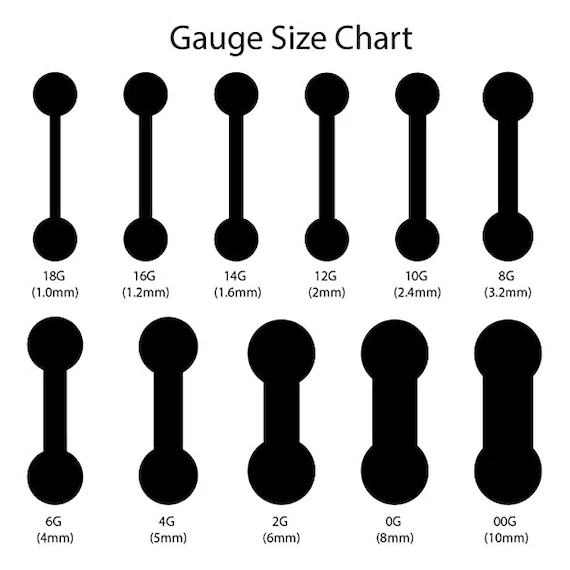
📏ゲージ (厚さ)
ゲージ ジュエリーバーまたはポストの厚さを指します. 通常測定されます アメリカのワイヤーゲージ (awg) - 数が低くなります, the 厚い ジュエリー.
ゲージ | ミリメートル (mm) | 一般的な使用 |
|---|---|---|
20g | 〜0.8 mm | 鼻孔, 耳葉 |
18g | 〜1.0 mm | 鼻, ヘリックス |
16g | 〜1.2 mm | 軟骨, リップ, トラガス |
14g | 〜1.6 mm | へそ, 産業, 乳首 |
12g | 約2.0 mm | 伸びるピアス |
💡 ヒントの場合: Piercerの推奨またはデフォルトのスタジオのサイジングに常に従ってください, 特にピアスを癒すため.
📐長さ
長さ バーベルまたはラブレットポストのウェアラブルエリアですか? 両端の間.
ピアスエリア | 一般的な長さ |
|---|---|
耳朶 | 6mm - 8mm |
トラガス | 6mm |
リップ / ラブレット | 8mm - 10mm |
へそ | 10mm - 12mm |
眉 | 8mm |
産業 | 35mm - 38mm |
🌀直径 (リング用)
直径 リングの内側の距離です, で測定 ミリメートル.
ピアスタイプ | 典型的な直径 |
|---|---|
セプタム | 8mm - 10mm |
ノーズリング | 6mm - 10mm |
旅 | 8mm |
乳首リング | 12mm - 16mm |
軟骨フープ | 6mm - 8mm |
サイズが重要な理由
✅ 短すぎます: 圧力を引き起こします, 腫れ, または埋め込み
✅ 長すぎる: 動きにつながります, 刺激, または引っ掛かります
✅ 正しいサイズ: 癒しを促進します, 快適, そして長期的な摩耗
多くのスタジオがお勧めします 最初のピアス 腫れに対応するために少し長い投稿で完了します - 癒しの後にサイズ変更されます.
7. ピアスジュエリーで使用される材料: 長所, 短所 & ユースケース
安全性に関しては, 耐久性, と美学, 材料 ジュエリーのピアスの重要な要素です. 間違った材料はアレルギー反応につながる可能性があります, 癒しの遅れ, または腐食 - 適切な人は何年もスタイルと快適さの両方を確保することができます.
🔩チタン (例えば。, ASTM F136 / G23)
長所:
低刺激性およびニッケルフリー
軽量だが強い
耐性耐性
陽極酸化に最適です (虹色)
に最適です:
新鮮なピアス, 敏感肌, プロのスタジオ
👉関連: 卸売チタンの究極のガイド & ステンレススチールジュエリー
👉も参照してください: ASTM F136チタン対. 316Lステンレス鋼: ピアスジュエリーに最適な素材
🔧ステンレス鋼 (316l / ASTM F138)
長所:
手頃な価格で耐久性があります
耐性耐性
洗練された仕上げ, 現代の美学
短所:
トレースニッケルが含まれています (誰にとっても理想的ではありません)
チタンよりわずかに重い
に最適です:
癒されたピアス, インダストリアルスタイルのジュエリー, 大量のB2B購入
🧪バイオプラスチック / PTFE
長所:
柔軟で快適です
低刺激性
オートクレーブ可能 (滅菌に適しています)
短所:
耐久性が低い
すべての美学には適していません
に最適です:
妊娠腹が鳴ります, 初期リップ/ラブレットピアス, 医療使用
物質的な安全性のヒント
常に材料があることを確認してください 認定 (例えば。, チタン用ASTM F136または鋼用ASTM F138) 評判の良いメーカーから調達されました. トレーサビリティのない一般的な「手術鋼」またはミステリー金属を避けてください.
8. 宝石の裏地と閉鎖: 機能的およびスタイルの考慮事項
タイプの 閉鎖メカニズム ピアスジュエリーで使用されることは、便利な問題だけではありません。それは快適さに影響します, 衛生, 安全性, と美学. 異なる閉鎖は、ピアスの場所に基づいてさまざまな目的を果たします, personal preference, and lifestyle needs.
🔒 Common Closure Types:
1. ネジ付き (Internal & External)
Internal thread: the post is smooth, and the threading is inside; ideal for initial piercings (less tissue trauma)
External thread: the threading is on the outside of the post; more affordable but less ideal for fresh piercings
✅ Recommended for: ラブレット, barbells, tongue rings, industrial barbells
2. スレッドレス (Push-Fit / Press-Fit)
Uses tension instead of screw threads
Cleaner look, easier insertion/removal
Especially popular in modern studios and higher-end jewelry
✅ Recommended for: ヘリックス, 鼻孔, トラガス, labret jewelry
👉も参照してください: 完璧なラブレットジュエリーのサイズを選択します
3. Clicker
Hinged segment ring that clicks into place
Easy to open and close, secure fit
Great for seamless look in nose, セプタム, or daith piercings
✅ Recommended for: セプタム, 旅, ヘリックス, cartilage piercings
🔗関連: 円形のバーベルのノーズリング: 選択 & ヒントを着ています
4. Captive Bead Ring (CBR)
Classic style where a single bead is held by tension
Offers 360° rotation, minimal design
Slightly trickier to insert/remove
✅ Recommended for: Ears, 鼻孔, 乳首, 眉
5. Fixed Ball or No-Closure (シームレス)
Offers a minimal look
Some seamless rings require bending to open/close
Not ideal for constant changing
✅ Recommended for: 鼻孔, ヘリックス, 巻き貝
How to Choose the Right Closure:
Consideration | Best Option |
|---|---|
First-time piercings | Threadless or internal thread |
毎日のウェア | Clicker or threadless |
Minimalist look | Seamless or fixed bead |
Secure hold for active users | Threaded or clicker |
Choosing the right closure isn’t just about looks—快適, 安全性, and ease of cleaning are just as important. If you’re unsure, threadless or clicker-style jewelry offers the best of both worlds.
9. How to Match Jewelry Type to Piercing Location
Not all jewelry types are suitable for every piercing. 権利を選択します structure, 形, and material for a specific location can influence healing time, 快適, and long-term wearability. Here’s a location-by-location guide to help you or your customers make informed decisions.
👂耳のピアス
ローブ:
に最適です: Studs, ラブレット, captive bead rings
注意事項: Heals quickly; versatile for many styles
ヘリックス / 軟骨:
に最適です: バーベル, クリッカー, スタッド
注意事項: Thinner skin, longer healing time—smooth edges are a must
トラガス / 旅 / Rook:
に最適です: 円形のバーベル, クリッカー, 湾曲したバーベル
注意事項: Opt for smaller gauges and comfortable closures
👃ノーズピアス
鼻孔:
に最適です: Nose studs, hoops, L-shaped pins
注意事項: Choose flat backs or screw-on studs to prevent irritation
セプタム:
に最適です: 円形のバーベル, クリッカー, シームレスなリング
注意事項: Avoid sharp edges or heavy pieces during healing
👄リップ & 経口ピアス
ラブレット / モンロー / メデューサ:
に最適です: Flat-back labrets, threadless posts
注意事項: Look for jewelry with smooth backs to protect gums and teeth
Tongue:
に最適です: バーベル (titanium preferred)
注意事項: Use internally threaded jewelry to reduce tissue damage
💉 Eyebrow Piercings
に最適です: Curved barbells or surface bars
注意事項: Avoid large gauge jewelry; go for lighter-weight options for comfort
✨ Body Piercings
へそ (Belly Button):
に最適です: Curved barbells, dangle navel rings
注意事項: Avoid overly heavy dangles for fresh piercings
乳首:
に最適です: バーベル, クリッカー, シールド
注意事項: Opt for materials with excellent biocompatibility like 316L or F136 titanium
🔗関連: 最高のピアスジュエリー素材の安全ガイド
10. 各ジュエリータイプの材料選択
権利を選択します 材料 ジュエリースタイルを選択するのと同じくらい重要です. 間違った材料は刺激を引き起こす可能性があります, 癒しを遅らせます, または、特に新鮮なピアスでアレルギー反応につながることさえあります. 以下は、一般的な素材の簡単な概要とその最良の用途です:
🛡チタン (ASTM F136 / F1295)
に最適です: すべてのピアス, 特に新鮮なもの
なぜそれを選ぶのか:
低アレルゲン性および生体適合性
軽量および腐食耐性
陽極酸化に最適です (鮮やかな色のオプション)
🧲316L手術ステンレス鋼
に最適です: 癒されたピアス, 予算に配慮したオプション
なぜそれを選ぶのか:
手頃な価格で広く利用可能です
まともな腐食抵抗で耐久性があります
トレースニッケルが含まれる場合があります (超敏感な肌には理想的ではありません)
🌿バイオフレックス & PTFE (柔軟なプラスチック)
に最適です: 経口ピアス, 妊娠, 医療処置
なぜそれを選ぶのか:
柔軟で軽量
金属フリー (イメージングに安全です, 手術)
Ideal for retainers and temporary replacements
Pro Tips for Material Selection
New Piercings? Stick with titanium or 316L steel
Sensitive skin? Go nickel-free—Titanium is your best friend
Style-focused buyers? Offer a gold or anodized titanium option
Studios/retailers? Always verify certifications (例えば。, ASTM F136, Mill Certification)
11. Threading Types: ネジ付き, スレッドレス & Clicker Explained
When it comes to the 機構 that holds your jewelry together, the threading style plays a big role in both comfort and practicality. Here’s how each type works and when to use them:
🔩ねじ付きジュエリー
説明: The decorative end (top) is screwed onto the post/bar.
External Thread: Threads are on the outside of the post. Less ideal for healing piercings as it can scrape tissue.
Internal Thread: Threads are inside the post—safer and smoother during insertion.
✅ に最適です: Experienced users and secure applications like barbells or industrials.
✨ Threadless Jewelry (プッシュフィット)
説明: A flexible pin on the decorative end is pushed into a hollow post, held by tension.
Easier and faster to insert
No threading = less trauma during changes
Popular with studios for nose, 耳, and labret piercings
🔗関連: Threadless Jewelry: Why It’s Popular in Modern Piercings
🔁 Clicker Jewelry
説明: Features a hinge and clasp that “clicks” shut.
Seamless look
No tools required
Common in septum, 旅, ヘリックス, and cartilage piercings
Quick Comparison
タイプ | Secure? | 簡単に変更できます? | に最適です |
|---|---|---|---|
ネジ付き | ✅ High | ❌ Moderate | バーベル, industrials |
スレッドレス | ✅ High | ✅ Very Easy | 鼻, lips, ear studs |
Clicker | ✅ High | ✅ Very Easy | セプタム, 旅, ヘリックス, rings |
12. Piercing Jewelry Sizes: Gauges, Lengths & Diameters
Choosing the right size is just as important as picking the right material or style—especially when it comes to comfort, ヒーリング, と美学.
📏 What is a Gauge?
The ゲージ (g) measures the thickness of the jewelry post or bar.
Lower number = thicker jewelry (例えば。, 14G is thicker than 18G)
Common gauges:
20G–18G: nose rings, ear studs
16G–14G: 軟骨, セプタム, リップ, and eyebrow
12G and above: stretched piercings, industrials
📐 Length and Diameter
長さ refers to how long the wearable part is (例えば。, post or barbell)
直径 applies to circular jewelry like hoops, CBR, and clickers
Example Reference Table:
ピアスタイプ | Recommended Gauge | Recommended Length/Diameter |
|---|---|---|
鼻孔 | 18G–20G | 6mm–8mm (post) / 8mm–10mm (ring) |
Labret/Lip | 14G–16G | 6mm–10mm |
眉 | 16g | 8mm–10mm |
へそ | 14g | 10mm |
Helix/Cartilage | 16g | 6mm–8mm |
セプタム | 14G–16G | 8mm–10mm |
⚠️ Size Matters for Healing
Too tight = pressure, 腫れ, 刺激
Too loose = snagging, migration risk
💡 Always consult a professional piercer when unsure of proper sizing.
13. Materials for Piercing Jewelry: Beyond Titanium & ステンレス鋼
While インプラントグレードチタン そして 316Lステンレス鋼 remain the gold standard in piercing jewelry, other materials are also used in specific contexts. Let’s take a closer look:
🛠️ Popular Materials in the Market
材料 | 重要な機能 | Best Use Cases |
|---|---|---|
チタン (ASTM F136) | 低刺激性, 軽量, 耐性耐性 | 最初のピアス, 敏感肌, anodizing |
316Lステンレス鋼 | 耐久性, polished, 手頃な価格 | 癒されたピアス, aesthetic variety |
ニオブ | 低刺激性, similar to titanium, good for anodizing | 最初のピアス, color customization |
金 (14K+) | Biocompatible if nickel-free, elegant | 癒されたピアス, luxury body jewelry |
バイオプラスト/PTFE | フレキシブル, nickel-free, autoclavable | Pregnancy piercings, medical/sports use |
Glass (Borosilicate) | Smooth, inert, non-metallic | Ear plugs, トンネル, septum retainers |
Wood, Horn, Stone | Organic, breathable, handcrafted | Stretched lobes (only after full healing) |
❗ Materials to Avoid
Mystery metals or non-certified “surgical steel”
Acrylics for fresh piercings (non-autoclavable, porous)
Plated or coated metals (can chip or cause reactions)
👉関連: 最高のピアスジュエリー素材の安全ガイド
14. Jewelry Trends & Style Tips for Studios and Retailers
Staying on top of piercing jewelry trends isn’t just for fashion lovers—it’s crucial for 小売業者, studio owners, and distributors who want to stay competitive in a fast-moving market. Here are some top trends and practical tips that are shaping customer preferences in 2025.
🔮 Emerging Trends in Piercing Jewelry
1. Minimalist & Micro Designs
Ultra-small labrets, スタッド, and hoops are trending.
Popular for second and third ear lobe piercings, 鼻孔, and helix.
Matte and brushed finishes in titanium are gaining traction.
2. Color Customization
Anodized titanium in blue, 虹, 紫, and gold finishes is seeing a surge.
Studios offer color options per piercing area (例えば。, gold for nostrils, rainbow for cartilage).
👉関連: Understanding Anodizing Process – Titanium vs Stainless Steel
3. Threadless Jewelry Systems
Growing in popularity due to ease of use and secure fit.
Especially favored by professional piercers for initial jewelry.
4. Ethically Made & Certified Jewelry
Gen Z and Millennial buyers are more conscious of sourcing.
Jewelry with REACH, ASTM, or APP certifications is increasingly demanded.
5. Stacking & Mixing Styles
Customers mix barbells, hoops, そして クリッカー across the same ear or facial region.
Studios benefit from offering sets or curated bundles.
Style Tips for Retailers & Studios
Tip | Benefit |
|---|---|
Offer multiple sizes & thicknesses per model | Helps fit unique anatomy, reduces return rate |
Provide anodizing color charts in-store or online | Empowers customers to personalize selections |
Educate staff on material certifications | Builds trust and boosts upsells |
Keep top 5 styles in-stock at all times | Reduces wait time, increases walk-in conversions |
Display curated collections by piercing area | Enhances customer experience and decision-making |
15. Final Tips for Choosing the Right Jewelry for Your Business & Clients
Whether you’re a piercing studio, online retailer, or wholesaler, offering the right types of jewelry is key to success. Here’s a quick checklist to help you align your product offerings with what clients are looking for:
✅ Material Matters
Always stock インプラントグレードチタン (ASTM F136) そして 316Lサージカルスチール as your base metals. These are biocompatible, 認定, and trusted by professional piercers.
👉 Learn more: 卸売チタンの究極のガイド & ステンレススチールジュエリー
✅ Focus on Fit & 関数
Offer a range of post lengths そして ゲージ to fit different anatomies.
Prioritize threadless or internally threaded designs for initial piercings.
Consider ergonomics: curved barbells for navels, straight for industrials, hinged rings for septums, 等.
✅ Listen to Studio Trends
Regularly ask your B2B clients:
What styles are popular right now?
Are customers asking for specific finishes (matte, 陽極酸化, polished)?
Do they need small batches of custom-engraved or color-coded jewelry?
✅ Curate for Piercing Areas
Instead of offering only by SKU, create sections like:
“Jewelry for Nostril Piercings”
“Best Clickers for Septum & Daith”
“Top Labrets for Helix & Lip”
✅ Build Trust with Documentation
Clearly label all materials and manufacturing specs.
Offer certificates of origin or mill test reports for titanium and surgical steel.
Provide easy-cleaning and aftercare tips with purchase.
📦 Bonus Tip: Starter Kits for Studios
Bundle jewelry by type or piercing area (例えば。, “Starter Set for Ear Projects”) to help new studios or resellers test different styles with minimal risk.
If you’re looking to stock high-quality wholesale piercing jewelry made from certified titanium and stainless steel, Sensagem is here to help.
お問い合わせ for custom quotes, catalogs, or sample kits tailored to your market.
Would you like me to compile all sections into a formatted export-ready article, or start working on the first cluster article in this second content cluster?
